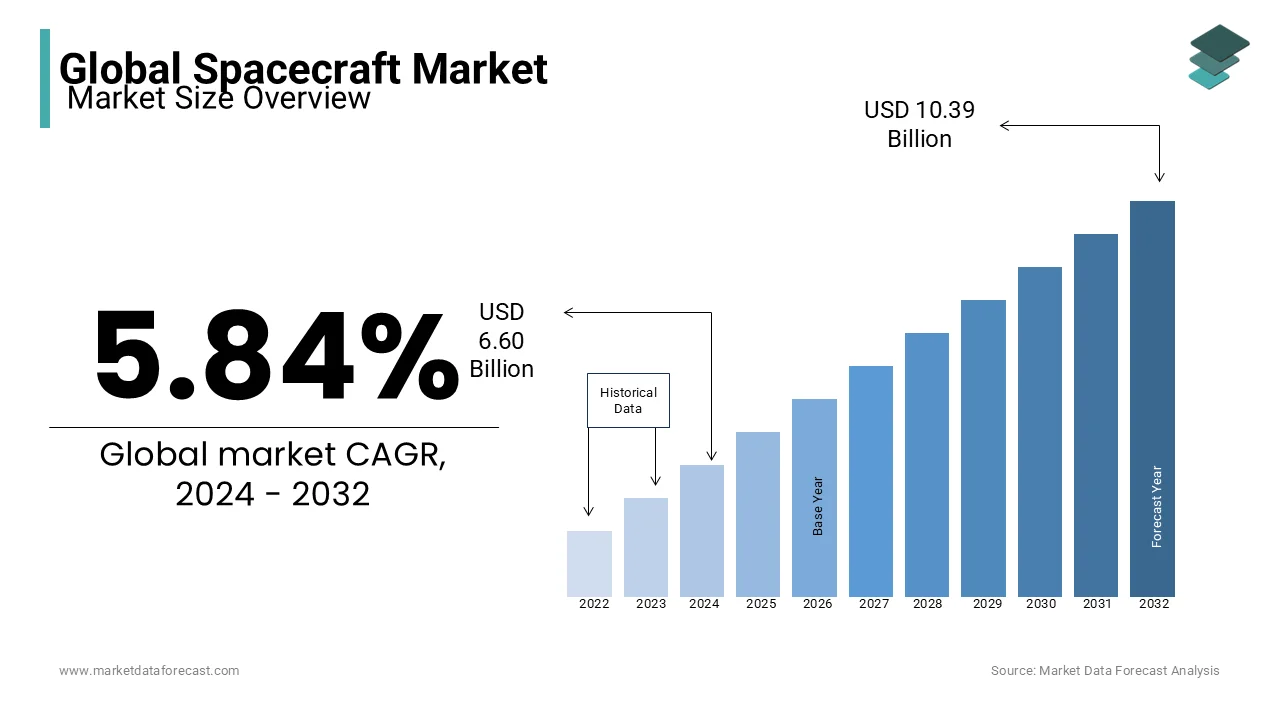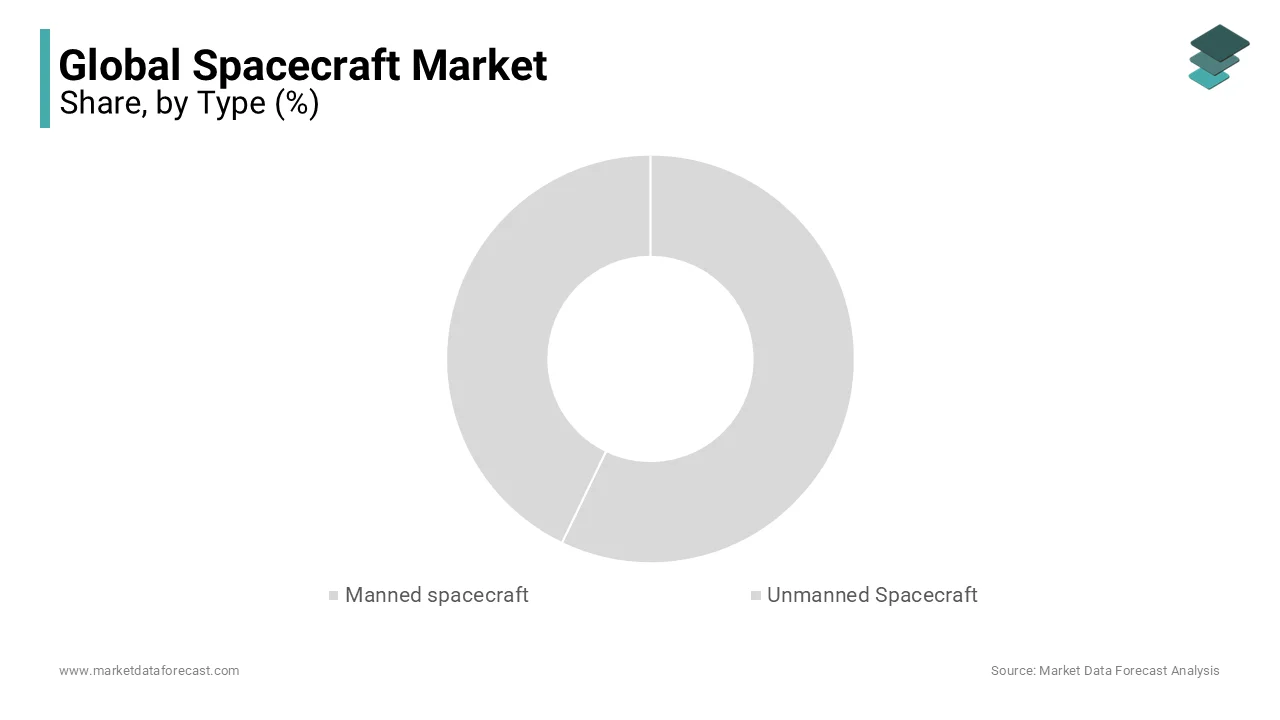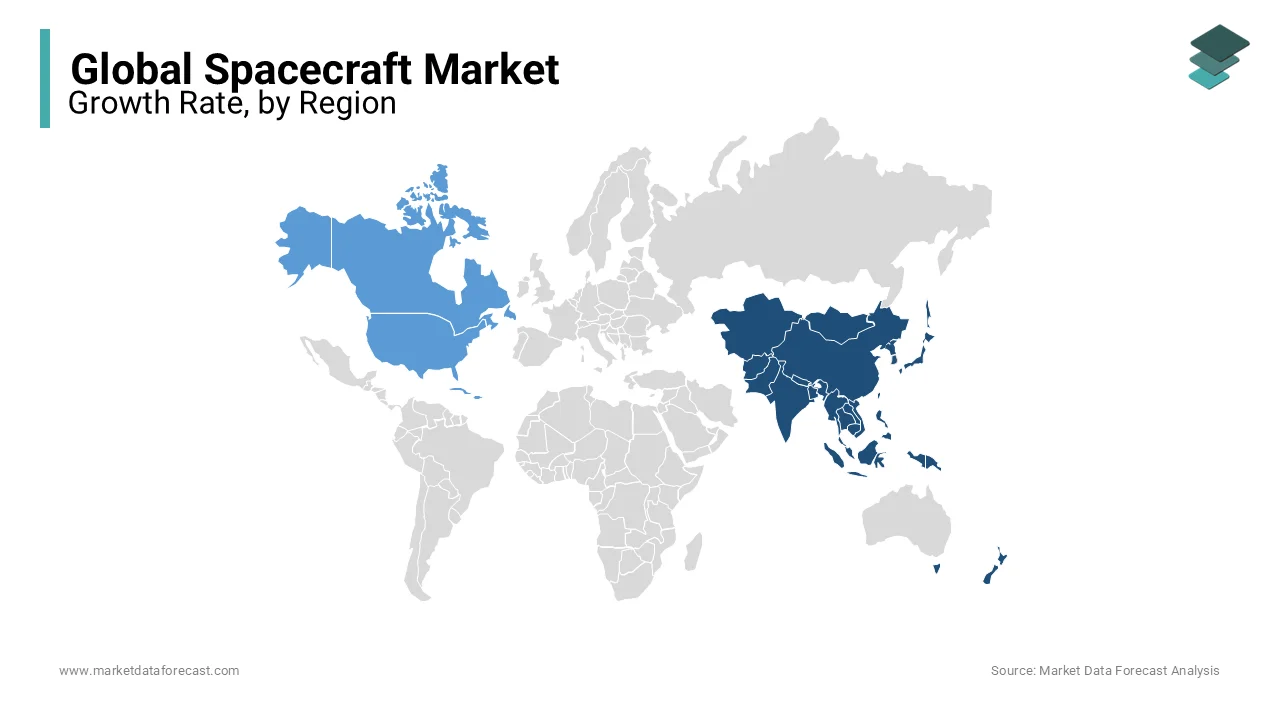Global Spacecraft Market Size, Share, Trends, & Growth Forecast Report – Segmented by type (Manned spacecraft and Unmanned Spacecraft), Application (Commercial and Military & Defense), & Region - Industry Forecast From 2024 to 2032
Global Spacecraft Market Size (2024 to 2032)
The global spacecraft market was worth USD 6.24 billion in 2023. The global market size is expected to reach USD 6.60 billion in 2024 and USD 10.39 billion by 2032, growing at a CAGR of 5.84% during the forecast period.

A spacecraft is a machine designed in such a way that it can be able to fly in space. It is an artificial satellite that is being tested for various tasks such as planetary exploration, navigation, and communications. The global spacecraft market for space Satellites has seen increasing demand for spacecraft from developed and developing economies. Moreover, only single-to-orbit-level vehicles do not require launch vehicles or a company rocket. Moreover, growing technological advances combined with spacecraft components are likely to offer the majority of the growth to the global spacecraft market in the next six years.
MARKET DRIVERS
Increasing competition among developed economies urges participants to immediately promote space missions, which creates a massive demand for the global spacecraft market.
The global spacecraft market is driven by the expansion of spacecraft and the space program of developed countries. In addition, the increase in government spending is expected to strengthen space operations, further driving the need for spacecraft. Over the last few decades, space exploration programs have gotten a lot of attention, and large countries have dominated the worldwide market by demonstrating their space capabilities. Furthermore, the expansion of space R&D projects has fueled the worldwide spacecraft industry. Likewise, growing cooperation among international space institutions for technology integration and investment reinforces the global market for space missions, driving demand for both human and unmanned spacecraft. The increase in space exploration missions could also be linked to increased government funding and space budgets. Furthermore, the global spacecraft market is expected to benefit from the shrinking of spacecraft components, which would drive application and demand.
MARKET RESTRAINTS
An unauthorized individual can use spacecraft because it can be controlled remotely. It takes longer for radio waves to travel from space to Earth since it functions in space. This will further affect the analysis to take longer. It doesn't provide people with a lot of options. It has a restricted maintenance provision, which reduces its lifespan. Atmospheric health risks due to exposure to radiation are mainly caused by long-term effects, which further limits the global spacecraft market growth in the upcoming years.
REPORT COVERAGE
|
REPORT METRIC |
DETAILS |
|
Market Size Available |
2023 to 2032 |
|
Base Year |
2023 |
|
Forecast Period |
2024 to 2032 |
|
CAGR |
5.84% |
|
Segments Covered |
By Type, Application, and Region |
|
Various Analyses Covered |
Global, Regional & Country Level Analysis, Segment-Level Analysis, DROC, PESTLE Analysis, Porter’s Five Forces Analysis, Competitive Landscape, Analyst Overview on Investment Opportunities |
|
Regions Covered |
North America, Europe, APAC, Latin America, Middle East & Africa |
|
Market Leaders Profiled |
The Boeing Company Airbus SE SpaceX Lockheed Martin Corporation Space Exploration Technologies Crop. Sierra Nevada Corporation Berlin Space Technologies GmbH Northrop Grumman Corporation Thales Alenia Space Millennium Space Systems OHB System AG |
SEGMENTAL ANALYSIS
Global Spacecraft Market Analysis By Type

The unmanned spacecraft category now holds the largest market share, which is likely to have during the projection period. Revenues from satellite launches, freight transportation spacecraft, and spacecraft for deploying land rovers for planetary exploration missions, among other things, are included in this part. Satellite launches have grown in recent years to support a variety of uses. Satellite launches are also likely to rise in the following years to support a variety of purposes, including military, commercial (such as telecommunications), and space research. Moreover, the inclusion of Artificial Intelligence (AI) technology in spatial operations enhances the growth of the global spacecraft market.
Global Spacecraft Market Analysis By Application
The commercial segment is anticipated to hold the highest spacecraft market share during the forecast period. Moreover, the commercial part offers the supply of goods and services with the help of equipment to the Earth's orbit or space. Furthermore, owners of these particular services generally have a contract to produce satellites and deliver them to various public and private industries, which form an integral part of the space economy. In addition, to the number of public benefits, commercial airline passengers appear to have the potential to catalyze the introduction of cost reductions. Furthermore, several thoughts have been implemented, like asteroid mines, solar sails, space colonies, and, mobile suits which have the capacity to play a significant key role in the global spacecraft market.
REGIONAL ANALYSIS

The Asia-Pacific is anticipated to generate the highest global spacecraft market share in the next six years. It is majorly due to increasing investments for space from emerging economies, including China, India, Japan, and South Korea. In addition, China is actively investing in space technology to catch up to the United States. The Chinese government and private enterprises are investing heavily in earth observation, satellite communications, and satellite manufacturing. These substantial investments have resulted in the creation and launch of several military and commercial satellites. As a result, China was the second-largest country in terms of operational satellites in orbit, after the United States.
North America tends to have the highest CAGR in the global spacecraft market. The presence of NASA in the region contributes to the region's dominance. NASA's extraterrestrial activities have a considerable budget. The presence of many major market players in the area, such as Lockheed Martin Corporation and Boeing Company, is projected to boost the worldwide spacecraft market's growth in the future years.
KEY MARKET PLAYERS
- The Boeing Company
- Airbus SE
- SpaceX
- Lockheed Martin Corporation
- Space Exploration Technologies Crop.
- Sierra Nevada Corporation
- Berlin Space Technologies GmbH
- Northrop Grumman Corporation
- Thales Alenia Space
- Millennium Space Systems
- OHB System AG
RECENT HAPPENINGSIN THE MARKET
- In April 2021, SpaceX launches 60 more Starlink Satellites, increasing the number of satellites introduced to 300 over a month. These satellites are being introduced as part of the company's goal to launch 1,500 Starlink satellites by 2021.
- On 11 March 2021, Airbus was appointed by the European Commission to study the development of space missions through the Horizon 2020 Plan. This is a precursor to the future creation of large structures in orbit. Direct production in orbit will change the way space systems are designed, built, and used.
By Type
- Manned spacecraft
- Unmanned Spacecraft
By Application
- Commercial
- Military
- Defense
By Region
- North America
- Asia-Pacific
- Europe
- Latin America
- Middle-East-America
Frequently Asked Questions
What are the primary applications of spacecraft in the market?
The primary applications include communication (satellites for internet, TV, and phone services), Earth observation (weather forecasting, environmental monitoring), navigation (GPS systems), and scientific research (planetary exploration, astrophysics studies).
What are the key technological trends driving the spacecraft market?
Key technological trends include reusable rocket technology, miniaturization of satellites (e.g., CubeSats), advancements in propulsion systems, and the development of mega-constellations of small satellites for global internet coverage.
What are the challenges facing the global spacecraft market?
Key challenges include high costs of development and launch, regulatory hurdles, space debris management, and geopolitical tensions that can impact international collaborations and satellite operations.
How does space tourism fit into the spacecraft market?
Space tourism is an emerging segment of the spacecraft market, with companies like Blue Origin, SpaceX, and Virgin Galactic offering suborbital and orbital flights for private individuals. This segment is expected to grow, contributing to market expansion and fostering public interest in space exploration.
Related Reports
Access the study in MULTIPLE FORMATS
Purchase options starting from $ 2500
Didn’t find what you’re looking for?
TALK TO OUR ANALYST TEAM
Need something within your budget?
NO WORRIES! WE GOT YOU COVERED!
Call us on: +1 888 702 9696 (U.S Toll Free)
Write to us: [email protected]